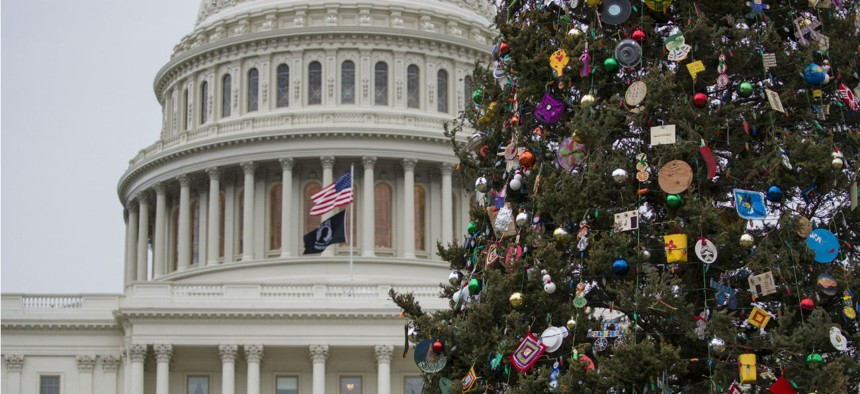
Alex Brandon/AP
Hiring Initiatives, Funding Windfalls and Other Major Takeaways for Federal Agencies in the 2020 Spending Bills
Two bills setting the line-by-line allocation of $1.4 trillion are set to become law later this week.
The House on Tuesday passed two spending bills that would set line-by-line funding levels for agencies across government, allocating $1.4 trillion in all.
The Senate is expected to pass the measures later this week and the White House has said President Trump would sign them into law to avoid a shutdown Friday evening. Under a two-year budget deal Trump signed earlier this year, both defense and non-defense agencies are set to receive significant funding increases for the current fiscal year. A slate of policy changes that will impact federal employees and operations across government also made their way into the final appropriations language, including a 3.1% pay raise for the entire workforce.
Below are 10 major impacts of the funding bills, including hiring pushes, administration proposals accepted and rejected and agencies that will make out particularly well once the measures are signed into law.
- State Department Hiring: The bill includes a provision originally in the House version of appropriations that will direct State and the U.S. Agency for International Development to restore staffing levels to those the agencies maintained prior to Trump taking office and before the administration issuing an extended hiring freeze. That would require State to maintain 12,870 civil service staff and 13,031 permanent Foreign Service officers. USAID would be staffed at 1,600 civil servants and 1,850 FSOs, required to deliver a workforce plan to Congress and authorized to suspend its normal centralized hiring board.
- Other Hiring: Several agencies would be in line for staffing increases under the funding bills. The Social Security Administration would receive an extra $100 million to hire more front-line staff and fund other means to boost its customer service. Lawmakers directed the Labor Department to boost staffing in its Wage and Hour Division to "restore WHD's investigative capacity," and for the National Labor Relations Board to reverse its workforce shortfalls. They called personnel reductions at the Education Department troubling and ordered it to develop a plan to "ensure adequate staffing levels are achieved for the department to meet its obligations."
- Homeland Security Workforce Changes: Congress once again rejected Homeland Security Department hiring where Trump most wanted it: Border Patrol and Immigration and Customs Enforcement, where he has requested thousands of new agents. The measures would allow for new Border Patrol coordinators, which Republicans said would enable 240 agents to go back to the frontlines. Overall, Customs and Border Protection would see funding decreased by $44 million, although negotiators included $1.4 billion for physical barriers along the U.S.-Mexico border, and ICE would see an increase of $492 million. CBP would receive funding to hire 800 new customs officers. The bills would also create a new "immigration detention ombudsman," who would report to the secretary and investigate and resolve complaints against DHS personnel. The Transportation Security Administration would receive funding for 1,090 new screeners, who lawmakers said would reduce wait times at airports.
- Reorganization Rejection: The funding bills largely block the Trump administration from its major efforts to restructure federal agencies. Following a similar provision in the annual defense authorization bill, lawmakers are seeking to prevent the elimination of the Office of Personnel Management and redistribution of its responsibilities to the General Services Administration and Office of Management and Budget. The measures provide no funding for the Bureau of Land Management to relocate its headquarters and hundreds of positions to western states. BLM previously said it already had sufficient funding to complete the move, but with Congress blocking additional funding, BLM would be prevented from providing incentive payments to employees. A spokesman on Tuesday said the agency was still reviewing the impact of the legislation. Lawmakers further sought to block the Agriculture Department from realigning any of its components, as the Trump administration has proposed, but a spokesman said the language would not prevent USDA from moving two agencies to Kansas City, Missouri.
- Transportation Cuts: In a funding bill chock-full of spending increases at nearly every department in government, the Transportation Department would endure a $324 million cut. The Federal Transit Administration would suffer the most among Transportation agencies, seeing its funding slashed by $503 million. Most of those cuts would stem from reductions to capital investment and transit infrastructure grants.
- Unusual Increase: For the last decade, the Corporation for Public Broadcasting has seen its funding kept flat or reduced. That is set to change in fiscal 2020, with lawmakers allocating $465 million, a $20 million increase. Trump has repeatedly sought to eliminate federal funding for CPB.
- Expected Increase: As it has for years, Congress is poised to give the Veterans Affairs Department a large funding increase. Its budget would be a record $216.5 billion, a more than $19 billion jump. Lawmakers directed VA to provide them with quarterly updates on efforts to increase staffing, with a focus on mental health and providers in rural areas, as well as $9 billion for the department to continue implementing the Mission Act's health care overhaul.
- Emergency Response: The Federal Emergency Management Agency would receive one of the largest spending bumps—34%—of any agency in government. That funding level is $4 billion more than Trump's request.
- Moonshot: NASA would see its funding increased by $1.1 billion, a 5% bump. Most of those new funds would go toward the agency's exploration division, with a focus on returning astronauts to the moon by 2024.
- Preparing for Transition: The measures would provide the General Services Administration with $9.6 million as it begins its efforts to prepare presidential campaigns and agencies for a potential transition to a new administration in 2021.







